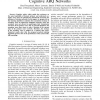Free Online Productivity Tools
i2Speak
i2Symbol
i2OCR
iTex2Img
iWeb2Print
iWeb2Shot
i2Type
iPdf2Split
iPdf2Merge
i2Bopomofo
i2Arabic
i2Style
i2Image
i2PDF
iLatex2Rtf
Sci2ools
GLOBECOM
2010
IEEE
2010
IEEE
Learning Interference Strategies in Cognitive ARQ Networks
Cognitive radios, which enable the coexistence on the same bandwidth of licensed primary and unlicensed secondary users, have the potential for dramatically increasing the efficiency of wireless networks. In this paper, we propose an on line learning algorithm to optimize the transmission strategy of secondary users in interference mitigation scenarios, where the secondary users are allowed to superimpose their transmission onto those of the primary users. Due to practical limitations, the secondary users have access to only a fraction of the current state of the primary users' network. Therefore, the strategy of the secondary users is defined on a reduced state space. Numerical results show that the proposed practical learning algorithm operates close to the performance of the system under full knowledge.
| Added | 11 Feb 2011 |
| Updated | 11 Feb 2011 |
| Type | Journal |
| Year | 2010 |
| Where | GLOBECOM |
| Authors | Sina Firouzabadi, Marco Levorato, Daniel O'Neill, Andrea J. Goldsmith |
Comments (0)

